Lumbricals of the hand
| Lumbricals of the hand | |
|---|---|
.png.webp) The muscles of the left hand. Palmar surface. (first lumbricalis labeled at bottom right of muscular group) | |
| Details | |
| Origin | flexor digitorum profundus |
| Insertion | extensor expansion |
| Artery | superficial palmar arch, common palmar digital arteries, deep palmar arch, dorsal digital artery |
| Nerve | Third and fourth deep branch of ulnar nerve, first and second median nerve |
| Actions | flex metacarpophalangeal joints, extend interphalangeal joints |
| Identifiers | |
| Latin | musculi lumbricales manus |
| TA98 | A04.6.02.065 |
| TA2 | 2532 |
| FMA | 37385 |
| Anatomical terms of muscle | |
The lumbricals are intrinsic muscles of the hand that flex the metacarpophalangeal joints,[1] and extend the interphalangeal joints.[1][2]
The lumbrical muscles of the foot also have a similar action, though they are of less clinical concern.
Structure
The lumbricals are four, small, worm-like muscles on each hand. These muscles are unusual in that they do not attach to bone. Instead, they attach proximally to the tendons of flexor digitorum profundus,[1][2][3] and distally to the extensor expansions.[1][3] The first and second lumbricals are unipennate, while the third and fourth lumbricals are bipennate.[2][4]
| # | Form | Origin | Insertion |
| First | unipennate | It originates from the radial side of the most radial tendon of the flexor digitorum profundus (corresponding to the index finger). | It passes posteriorly along the radial side of the index finger to insert on the extensor expansion near the metacarpophalangeal joint. |
| Second | unipennate | It originates from the radial side of the second most radial tendon of the flexor digitorum profundus (which corresponds to the middle finger). | It passes posteriorly along the radial side of the middle finger and inserts on the extensor expansion near the metacarpophalangeal joint. |
| Third | bipennate | One head originates on the radial side of the flexor digitorum profundus tendon corresponding to the ring finger, while the other originates on the ulnar side of the tendon for the middle finger. | The muscle passes posteriorly along the radial side of the ring finger to insert on its extensor expansion. |
| Fourth | bipennate | One head originates on the radial side of the flexor digitorum profundus tendon corresponding to the little finger, while the other originates on the ulnar side of the tendon for the ring finger. | The muscle passes posteriorly along the radial side of the little finger to insert on its extensor expansion. |

Nerve supply
The first and second lumbricals (the most radial two) are innervated by the median nerve. The third and fourth lumbricals (most ulnar two) are innervated by the ulnar nerve.[5]
This is the usual innervation of the lumbricals (occurring in 60% of individuals). However 1:3 (median:ulnar - 20% of individuals) and 3:1 (median:ulnar - 20% of individuals) also exist. The lumbrical innervation always follows the innervation pattern of the associated muscle unit of flexor digitorum profundus (i.e. if the muscle units supplying the tendon to the middle finger are innervated by the median nerve, the second lumbrical will also be innervated by the median nerve).[6]
Blood supply
Four separate sources supply blood to these muscles: the superficial palmar arch, the common palmar digital artery, the deep palmar arch, and the dorsal digital artery.[7]
Function
The lumbrical muscles, with the help of the interosseous muscles, simultaneously flex the metacarpophalangeal joints while extending both interphalangeal joints of the digit on which it inserts. The lumbricals are used during an upstroke in writing.
Etymology
The term "lumbrical" comes from the Latin, meaning "worm".[8]
Additional images
 Tendons of forefinger and vincula tendina
Tendons of forefinger and vincula tendina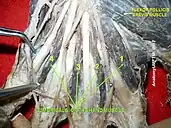 Lumbricals of the hand
Lumbricals of the hand Lumbricals of the hand
Lumbricals of the hand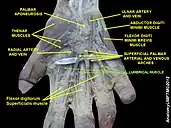 Lumbricals muscle
Lumbricals muscle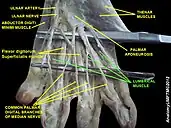 Lumbricals muscle
Lumbricals muscle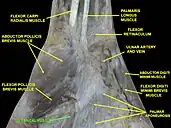 Lumbricals muscle
Lumbricals muscle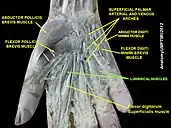 Lumbricals muscle
Lumbricals muscle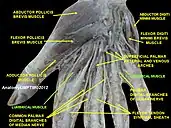 Lumbricals muscle
Lumbricals muscle Muscles of hand, cross section
Muscles of hand, cross section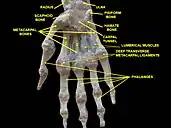 Wrist joint. Deep dissection.Anterior, palmar view
Wrist joint. Deep dissection.Anterior, palmar view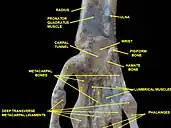 Wrist joint. Deep dissection.Anterior, palmar view
Wrist joint. Deep dissection.Anterior, palmar view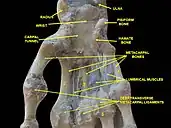 Wrist joint. Deep dissection.Anterior, palmar view
Wrist joint. Deep dissection.Anterior, palmar view
References
- 1 2 3 4 Gosling JA, Harris PF, Humpherson JR, Whitmore I, Willan PL (2008). Human Anatomy: Color Atlas and Textbook (5th ed.). Philadelphia: Mosby. ISBN 978-0-7234-3451-1. p. 97
- 1 2 3 Bilge O, Pinar Y, Ozer MA, Govsa F (October 2007). "The vascular anatomy of the lumbrical muscles in the hand". Journal of Plastic, Reconstructive & Aesthetic Surgery. 60 (10): 1120–6. doi:10.1016/j.bjps.2006.06.023. PMID 17825776.
- 1 2 Wang K, McGlinn EP, Chung KC (January 2014). "A biomechanical and evolutionary perspective on the function of the lumbrical muscle". The Journal of Hand Surgery. 39 (1): 149–55. doi:10.1016/j.jhsa.2013.06.029. PMC 4155599. PMID 24369943.
- ↑ Schweizer A (April 2003). "Lumbrical tears in rock climbers". Journal of Hand Surgery. 28 (2): 187–9. doi:10.1016/S0266-7681(02)00250-4. PMID 12631495. S2CID 244111.
- ↑ Lauritzen RS, Szabo RM, Lauritzen DB (February 1996). "Innervation of the lumbrical muscles". Journal of Hand Surgery (Edinburgh, Scotland). 21 (1): 57–8. doi:10.1016/s0266-7681(96)80013-1. PMID 8676031. S2CID 8084761.
- ↑ Sinnatamby CS (1999). Last's Anatomy: Regional and Applied (10th ed.). Edinburgh: Churchill Livingstone. pp. 64, 82. ISBN 978-0-443-05611-6.
- ↑ Zbrodowski A, Mariéthoz E, Bednarkiewicz M, Gajisin S (June 1998). "The blood supply of the lumbrical muscles". Journal of Hand Surgery. 23 (3): 384–8. doi:10.1016/S0266-7681(98)80063-6. PMID 9665531. S2CID 26384944.
- ↑ Bozer, Cüneyt; Uzmansel, Deniz; Dönmez, Didem; Parlak, Muhammed; Beger, Orhan; Elvan, Özlem (2018-12-01). "The effects of the communicating branch between medial and lateral plantar nerves on the innervations of the foot lumbrical muscles". Journal of the Anatomical Society of India. 67 (2): 130–132. doi:10.1016/j.jasi.2018.11.006. ISSN 0003-2778.